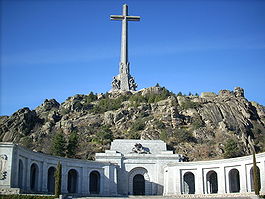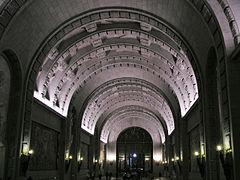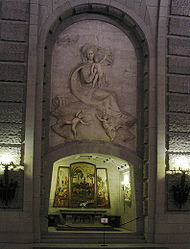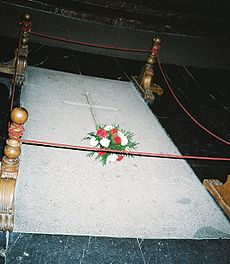- Valle de los Caídos
-
The Valley of the Fallen (Spanish: Valle de los Caídos) is a Catholic basilica and a monumental memorial in the municipality of San Lorenzo de El Escorial, erected at Cuelgamuros Valley in the Sierra de Guadarrama, near Madrid, conceived by Spanish dictator Francisco Franco to honour and bury those who fell during the Spanish Civil War. It was also claimed by Franco that the monument was meant to be a "national act of atonement".
The monument, a landmark of 20th-century Spanish architecture, was designed by Pedro Muguruza and Diego Méndez on a scale to equal, according to Franco, "the grandeur of the monuments of old, which defy time and forgetfulness". Together with the Universidad Laboral de Gijón, it is the most prominent example of the original Spanish Neo-Herrerian style, which was intended as a revival of Juan de Herrera's late renaissance architecture, exemplified in El Escorial. This uniquely Spanish architecture was widely used in public buildings of post-war Spain and is rooted in International classicism exemplified by Albert Speer or Mussolini's Esposizione Universale Roma.
The monument precinct encloses over 3,360 acres (13.6 km2) of Mediterranean woodlands and granite boulders on the Sierra de Guadarrama hills, over 3,000 feet (910 m) over sea level where stand the Basilica, the Benedictine Abbey, the Hospedería, the Valley and the ‘Juanelos,’ four cylindrical monoliths dating from the 16th century. The most prominent feature of the monument is the towering 150-meter-high (500 ft) cross erected over a granite outcrop 150 meters over the basilica esplanade and visible from over 20 miles (32 km) away.
Work started in 1940 and took over eighteen years to complete, the monument being officially inaugurated on April 1, 1958. According to the official ledger, the cost of the construction totalled 1.159 billion pesetas, funded through National Lottery draws and donations.
As a surviving artifact of Franco's rule, the monument and its Catholic basilica remain controversial, particularly because 10% of the construction workforce were convicts, some of them Popular Front prisoners.
The complex is owned and operated by the Patrimonio Nacional, the Spanish governmental heritage agency, and ranked as the third most visited monument of the Patrimonio Nacional in 2009. The Spanish socialist government closed the complex to visitors at the end of 2009, basing the decision on safety reasons connected to restoration on the facade. Controversy arose upon this decision, as the closure was attributed by part of the public opinion to the "Memoria Historica" law enacted during president Zapatero's mandate, as supported by some media.[1] Other media support that the abbey monks are misinterpreting the closure due to restoration works with a political decision.[2] The works include the Pietà sculpture prominently featured at the entrance of the crypt, using hammers and heavy machinery.[3][4] In November, 2010, alleging safety reasons, the Spanish government closed down the Basilica for Mass.[5] Mass was celebrated in the open during several weeks; with an attendance of 3.000 faithful, in a rainy day on November 14. Checkpoints were set up, according to government sources, to prevent political manifestations such as Falange flags, in accordance to the Law of "Memoria Histórica". However, Catholic sources claimed that the government was simply trying to interfere with the celebration of the Mass.
Contents
Basilica, cross and abbey
Main article: Basilica of the Holy Cross of the Valley of the FallenRising above the valley is one of the world's largest basilicas, Basílica de la Santa Cruz del Valle de los Caídos (Basilica of the Holy Cross of the Valley of the Fallen), hewn out of a granite ridge, and the tallest memorial cross in the world, a 152.4-metre-high construction of stone.
In 1960, Pope John XXIII declared the underground crypt a basilica. The dimensions of the underground basilica, as excavated, are larger than those of St. Peter's Basilica in Rome. To avoid competition, a partitioning wall was built near the inside of the entrance and a sizable entryway was left unconsecrated.
The monumental hieratic sculptures over the main gate and the base of the cross culminated the career of Juan de Ávalos. The monument consists of a wide explanada (esplanade) with a spectacular view of the valley and the outskirts of Madrid in the distance. A long vaulted crypt was tunnelled out of solid granite, piercing the mountain to the massive transept, which lies exactly below the cross.
On the wrought-iron gates, Franco's neo-Habsburg double-headed eagle is prominently displayed. On entering the basilica, visitors are flanked by two large metal statues of art deco angels holding swords.
There is a funicular that connects the basilica with the base of the cross. There is a spiral staircase and a lift inside the cross, connecting the top of the basilica dome to a trapdoor on top of the cross,[6] but their use is restricted to maintenance staff.
The Benedictine Abbey of the Holy Cross of the Valley of the Fallen (Spanish: Abadía Benedictina de la Santa Cruz del Valle de los Caídos), on the other side of the mountain, houses priests who say perpetual Masses for the repose of the fallen. The abbey ranks as a Royal Monastery.
Valley of the Fallen
The valley that contains the monument, preserved as a national park, is located 10 km northeast of the royal site of El Escorial, northwest of Madrid. Beneath the valley floor lie the remains of 40,000, whose names are accounted for in the monument's register.
Although the valley contains both Nationalist and Republican graves, the tone of the monument is distinctly Nationalist and anti-Communist, containing the inscription "¡Caídos por Dios y por España!" ("Fallen for God and Spain!"), reflecting the close ties of Franco's Nationalist regime to the Catholic Church. Additionally, the timing of Franco's announcement of the decision to create the monument suggests one side is being commemorated more than the other: on 1 April 1940, the day of the victory parade to celebrate the first anniversary of his triumph over the Republic, Franco announced his personal decision to raise a splendid monument to those who had fallen in his cause.[7]
The Basilica became then more consensual. Pope John XXIII declared it Minor Basilica the Church of Santa Cruz. "En este monte sobre el que se eleva el signo de la redención humana ha sido excavado una inmensa cripta, de modo que en sus entrañas se abre amplísimo templo, donde se ofrecen sacrificios expiatorios y continuos sufragios por los caídos de la Guerra Civil de España. Y allí acabados los padecimientos, terminados los trabajos, y aplacadas las luchas, duermen juntos el sueño de la paz, a la vez que se ruega sin cesar por toda la Nación Española". [8] 4/24/11
Franco's tomb
In 1975, after Franco's death, the site was designated by the interim government as the burial place for the Caudillo, who actually did not desire to be buried in the valley, but in Madrid. Unlike the fallen of the Civil War who were laid to rest in the valley exterior to the basilica, Franco was buried inside the church. His grave is marked by a simple tombstone engraved with his name, on the choir side of the main altar (between the altar and the apse of the Church; behind the altar, from the perspective of a person standing at the main door).
Franco was the second person buried in the Santa Cruz basilica. Franco had earlier interred José Antonio Primo de Rivera, founder of the Falange, the Spanish fascist party that aided his ascension to power, under a modest gravestone on the nave side of the altar. Primo de Rivera died November 20, 1936, exactly 39 years before Franco, whose grave is in the corresponding position on the other side of the altar.
A somewhat Controversial Monument
Presenting the monument in a politically neutral way poses a number of problems, not least the strength of opposing opinions on the issue. The Times quotes Jaume Bosch, a far-left politician seeking to change the monument, as saying: "I want what was in reality something like a Nazi concentration camp to stop being a nostalgic place of pilgrimage for Francoists. Inevitably, whether we like it or not, it's part of our history. We don’t want to pull it down, but the Government has agreed to study our plan."[9]
The charge that the monument site was "like a Nazi concentration camp" refers to the use of convicts, including Popular Front war prisoners, trading their labour for a conviction redemption: "The drilling of the Risco de la Nava was undertaken by San Roman, an affiliate of the incumbent construction company Agroman. The workforce was provided by the despair and hardship of the post war period. These were joined by Republican prisoners who were promised a conviction redemption for risking their lives working on the monument construction [...], which in 1943 amounted to six hundred.[10] Other souces point out up to 20.000 prisoners and speak about forced labour.[11]
The 1940 Spanish law did not allow for forced labour, but recognized the possibility of voluntarily redeeming two days of conviction for each working day to reduce the burden of a large convict population that included many war and political prisoners. This benefit was increased to six days when labour was carried out at the basilica with a salary of 7 pesetas per day, a fairly reasonable salary for that time, with the possibility of the family of the convict benefiting from the housing and children schools built on the valley for the other workers. Only convicts with a good behaviour record would qualify for this redemption scheme, as the works site was considered to be a low security environment. The motto used by the Spanish Nationalist government was "el trabajo enoblece" ("work ennobles").
According to the official programme records, 2,643 workers participated directly in the construction, some of them highly skilled, as required by the complexity of the work. 243 of them were convicts. During the eighteen-year construction period, the official tally of workers who died as result of accidents during the building of the monument totalled fourteen.[12]
Since 2004 the left-leaning Spanish government, which has been following a policy of the removal of Francoist symbols from public buildings and spaces, has had an uneasy relationship with a monument that is the most conspicuous legacy from Franco's rule. Political rallies in celebration of the former dictator are now banned by the Law of Historical Memory, voted on by the Congress of Deputies on 16 October 2007. This law dictated that "the management organisation of the Valley of the Fallen should aim to honour the memory of all of those who died during the civil war and who suffered repression".[13] It has been suggested that The Valley of the Fallen be re-designated as a "monument to Democracy" or as a memorial to all Spaniards killed in conflict "for Democracy".[14] Some organisations, among them centrist Catholic groups, question the purpose of these plans, on the basis that the monument is already dedicated to all of the dead, civilian and military of both Nationalist and Republican sides.
Closure of the monument
In November 2009, Patrimonio Nacional controversially ordered the closure of the basilica for an indefinite period of time, alleging preservation issues which also may affect the Cross and some sculptures.[15] These allegations have been contested by experts and the religious community that lives in the complex, and had been seen by some conservative opinion groups as a policy of harassment against the monument.[16] In 2010, the Pietà sculpture group started to be "dismantled" with hammers and heavy machinery, which according to the Juan de Avalos trust may result into irreparable damage of the masterpiece. As result, the trust has filed several lawsuits against Spanish government .[17] Several parallelisms has been made between the Pietà and the Buddhas of Bamyan by liberal and conservative groups[citation needed]. On the other hand, Spanish government followers assert that this process is fair to socialists, communists, and anarchists fallen during the Spanish Civil War[citation needed]. .
In Popular Culture
The Valle de los Caídos appears in Richard Morgan's 2002 novel Altered Carbon, where it is being used as a base of operations for one of the major antagonists, Reileen Kawahara.[18] It also appears in the 2010 Spanish comedy terror film The Last Circus (Spanish: Balada triste de trompeta). There is also a large reference to this monument and the labourours who built it in Victoria Hislop's book The Return.
References
- ^ Diario de la Sierra (10 de febrero de 2010). "Una decisión polémica: Ordenan el cierre del Valle de los Caídos por tiempo indefinido". http://www.diariodelasierra.es/2010/02/11/una-decision-que-traera-polemica-ordenan-el-cierre-del-valle-de-los-caidos-por-tiempo-indefinido. Retrieved 26 de abril de 2010.
- ^ http://www.elpais.com/solotexto/articulo.html?xref=20101115elpepinac_12&type=Tes&anchor=elpepunac
- ^ "El desmontaje de 'La Piedad' del Valle de los Caídos, a 'mazazo limpio'". El Mundo. 23 April 2010. http://www.elmundo.es/elmundo/2010/04/23/madrid/1272015241.html. Retrieved 26 de abril de 2010.
- ^ "Images that show how the sculpture is being destroyed". http://www.elvalledeloscaidos.es/.
- ^ Libertad digital (10 November 2010). "Valle de los caídos: cerrado por orden gubernativa". http://www.libertaddigital.com/sociedad/valle-de-los-caidos-cerrado-por-orden-gubernativa-1276406927/. Retrieved 11 November 2010.
- ^ "La Cruz monumental". http://www.vki2.net/c_monumental.htm.
- ^ The Valle de los Caidos
- ^ [1]
- ^ Spain reclaims Franco’s shrine
- ^ Cesar Vidal. "Como se realizó el Valle de los Caidos"
- ^ EJP
- ^ Cristina Rodenas, "Valle de los Caidos, Cronologia" ABC, September 15, 2008.
- ^ "Boletín Oficial de las Cortes Generales, 16 de octubre", report about the resolution voted at the Congreso de los Diputados
- ^ [2], Times on-line
- ^ "Una decision Polemica, ordenan el cierre del Valle de los Caidos por tiempo indefinido" Diario de la Sierra November 2009
- ^ Pio Moa "El Valle de los Caidos y los Talibanes" Libertad Digital, February 14, 2010
- ^ ["http://www.libertaddigital.com/sociedad/el-hijo-de-juan-de-avalos-denuncia-a-patrimonio-por-el-desmontaje-de-la-piedad-1276392693/ "Juan de Avalos's son claims against demolition of his father sculpture"]. "http://www.libertaddigital.com/sociedad/el-hijo-de-juan-de-avalos-denuncia-a-patrimonio-por-el-desmontaje-de-la-piedad-1276392693/.
- ^ Morgan, Ricahard K. (2002). Altered Carbon. Del Rey Book. p. 227. ISBN 9780345457684.
External links
- WAIS Forum on Spain, 2003: "Spain: the Valley of the Fallen": includes quote from Franco's decree, April 1, 1940
- Abadía de la Santa Cruz del Valle de los Caídos: Official Website (Spanish).
- El Valle de los Caidos: (Spanish)
- Fundacion Francisco Franco, Valle de los Caidos: from Franco's Memorial Trust (Spanish)
- Valley of the Fallen: visitor information and photos
- Cruz de los Caídos drawings and plans from the architectural website skyscraperpage.com
- The Valley of the Fallen: History and Photos.
- "Manifesto for historians regarding the Valley of the Fallen" by Pio Moa, leading Spanish historian about the construction of the monument and the alleged government policy of harassment (Spanish)
Royal sites of the Patrimonio Nacional Royal Palaces 
Monasteries Convent of Las Descalzas Reales · Convent of La Encarnación · Convent of Santa Clara · Abbey of Santa María la Real de Las Huelgas · Valle de los CaídosOther 'Casita del Príncipe · Casita del Infante · Pantheon of Illustrious Men · Convent of San Pascual · Convent of Santa Isabel · Colegio de Doncellas NoblesCategories:- Basilica churches in Spain
- Monuments and memorials in Spain
- Spanish Civil War
- Benedictine monasteries in Spain
- Monasteries in the community of Madrid
Wikimedia Foundation. 2010.






